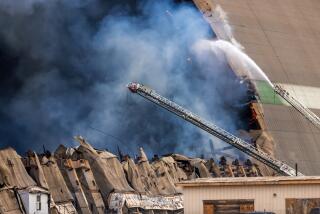Naval Base Ventura County Rockets Into the History Books
- Share via
As one of the world’s most sophisticated radar planes circled overhead, several hundred Point Mugu employees, alumni, and dignitaries paid tribute Friday to the base’s decades of developing and testing cutting-edge missiles.
With an E-2 Hawkeye droning above, Naval Base Ventura County at Point Mugu was formally named an American Institute of Aeronautics and Astronautics historic site. At the same time, the base opened a public exhibit center near its entrance off Wood Road.
The institute designation placed it in the company of about 20 other historic spots, including Kitty Hawk, N.C.; Dutch Flats, the San Diego airport where Charles Lindbergh’s “Spirit of St. Louis” was tested; and the Air Force Flight Test Center at Edwards Air Force Base, home of legendary test pilots and fledgling astronauts.
Also deemed historic was Tranquility Base, the landing site of the manned U.S. mission to the moon in 1969.
“That caused the institute a degree of a problem because we haven’t figured out how to get the plaque up there,” cracked Aubrey Smith, the institute board member who unveiled a plaque citing the Ventura County base’s groundbreaking achievements.
Smith’s audience included Navy brass, engineers who worked on some of the base’s early missiles, officials from area cities, and Rep. Elton Gallegly (R-Simi Valley), who has fought periodic efforts to shut the sprawling base.
After marches played by a military band, speeches and a rendition of “God Bless America,” officials cut the ribbon stretched across the exhibit center’s entrance.
“It seems more appropriate that we have a museum in this historic spot than a pizza parlor,” Gallegly said, alluding to one of the building’s recent uses.
Inside, the walls were lined with black-and-white photos of scientists and sailors, the backbone of Point Mugu’s staff since the base opened in 1946. On the floor were mounted missiles such as the Tomahawk and the Sparrow, which were tested in the skies over Point Mugu’s 30,000-square-mile sea range.
“I’m glad that someone was thinking about this,” said Michael Morcos, 70, an engineer now retired after more than two decades of working on missile systems at the base. “These weapons could easily be forgotten.”
Over the years, Point Mugu has been host to a number of firsts, including the firing of the first missile off a submarine and the first launch of a missile that destroyed an airborne target. Roads on the base are named after missiles tested there, including Orion, Lark, Gorgon and Regulus.
William Cuneen, a retired base vice commander and president of the Missile Technology Historical Assn., said one of Point Mugu’s most significant achievements was a 1973 exercise called “Six on Six.” It proved that the then-experimental F-14 fighter jet could fire six Phoenix missiles at six targets simultaneously. Four unmanned drone aircraft were downed and the F-14 went on to become a key part of the U.S. arsenal.
Although the historic designation awarded Friday carries no legal weight, it might awaken awareness of aerospace’s endangered history, the institute’s Smith said.
A number of landmarks are already gone, Smith said, partly because some are not old enough to be seen by the public as historic.
One site honored last year was the Pasadena plant where scientists for Aerojet Engineering invented rocket fuel in the 1940s. The building is now a car dealership whose owners, Smith said, “are extremely proud of the plaque.”
More to Read
Sign up for Essential California
The most important California stories and recommendations in your inbox every morning.
You may occasionally receive promotional content from the Los Angeles Times.














